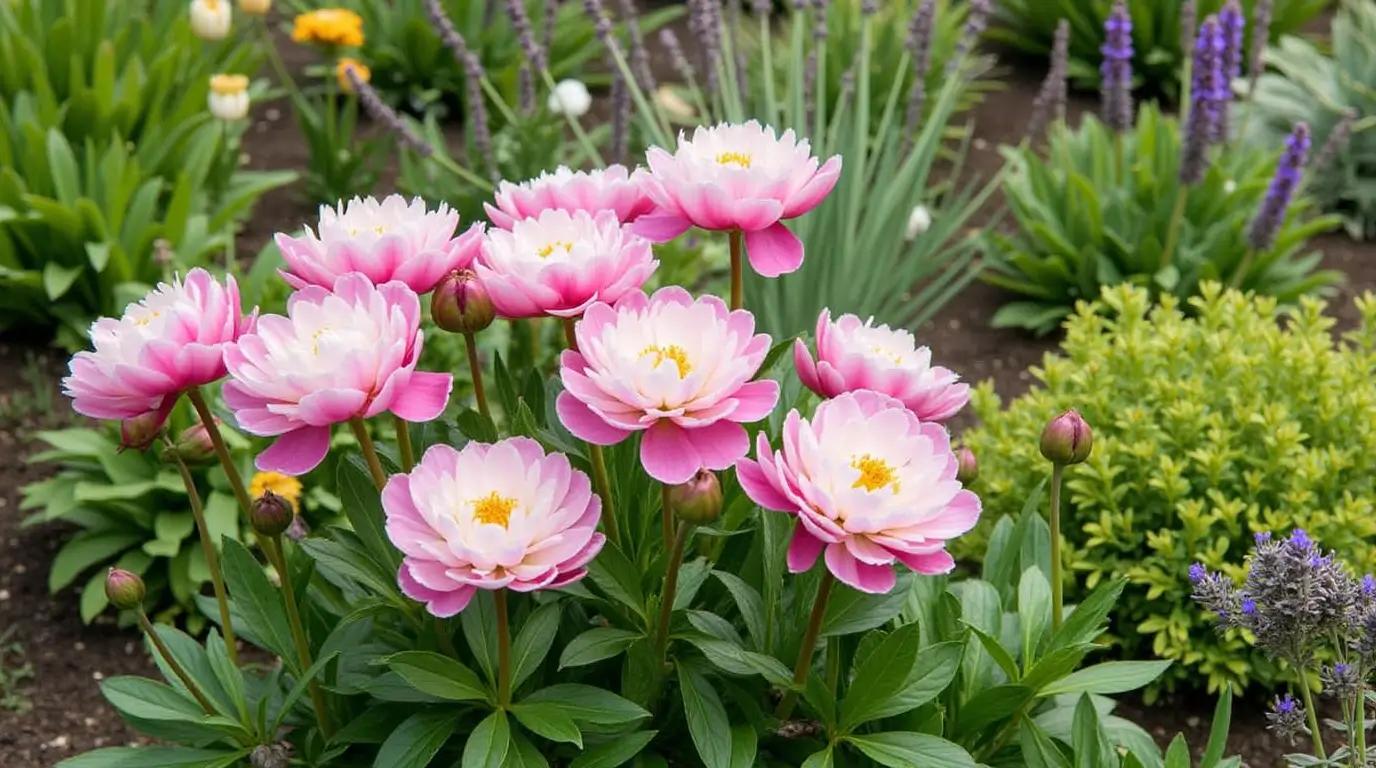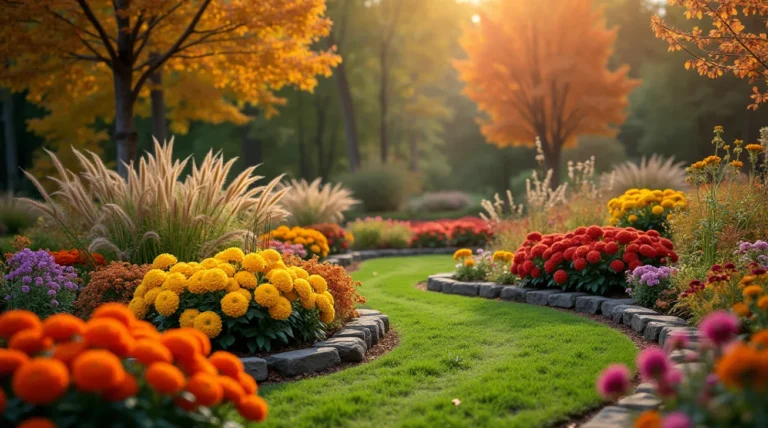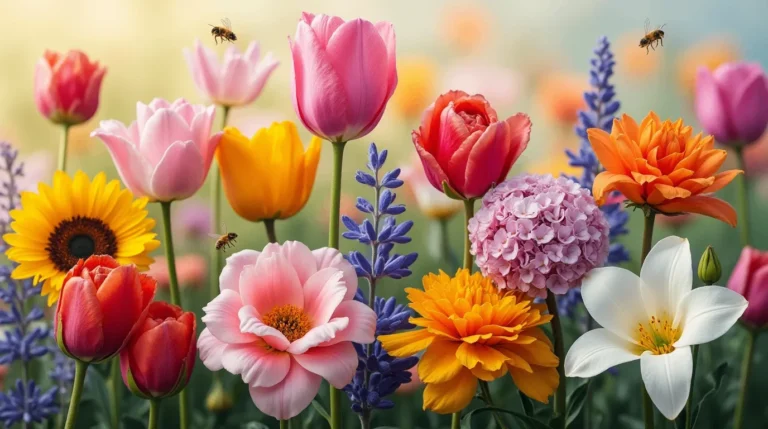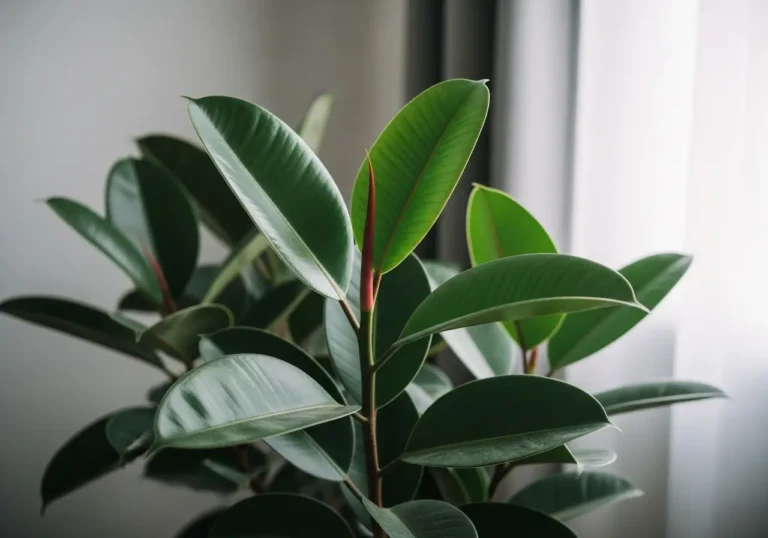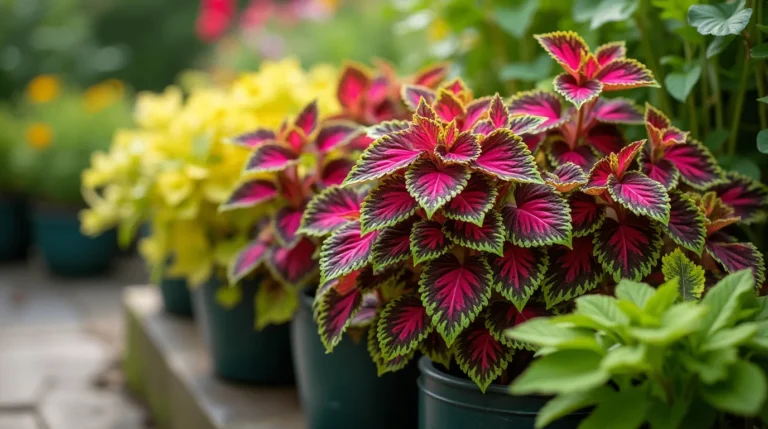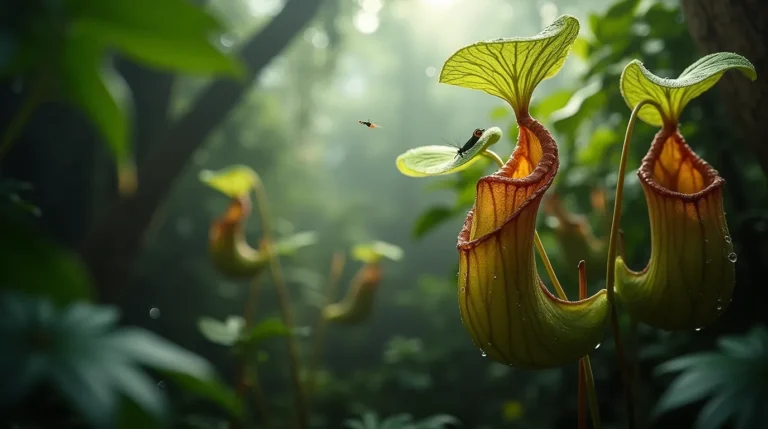Peonies Flowers: How To Create A Thrilling, Colorful Garden Oasis
Peonies Flowers are a favorite in garden design. They come in many colors and can brighten up any garden. With the right care, they can grow well in many places, making them perfect for all gardeners.
Creating a stunning peony garden involves several steps. You need to know which peonies to plant and how to care for them. By learning about peonies Flowers and how to use them in your garden, you can make a beautiful oasis that everyone will admire.
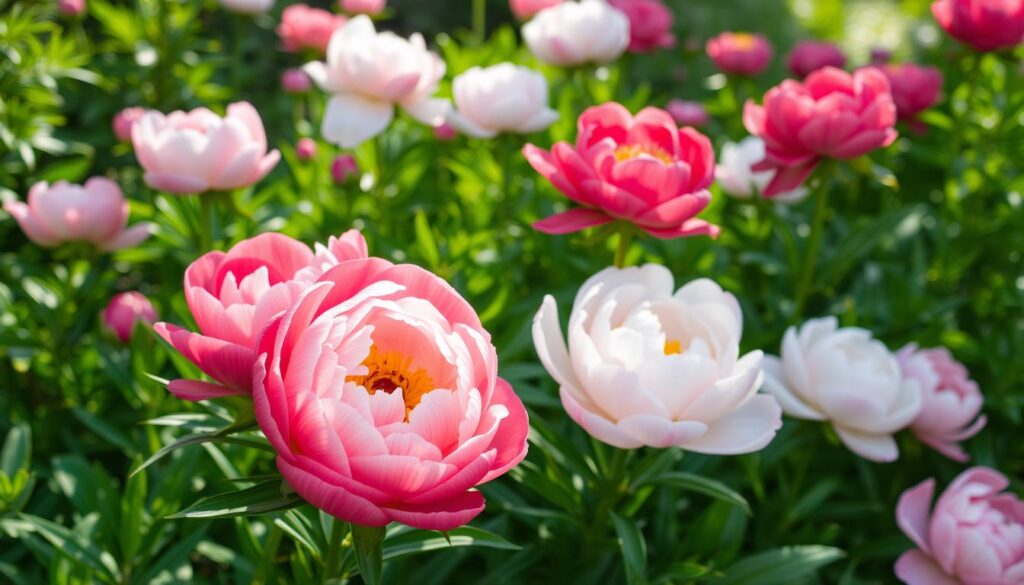
This guide is for both new and experienced gardeners. It will teach you how to grow a beautiful peony garden. We’ll cover planting, care, flower arrangement, and maintenance. This way, you can create a stunning garden that showcases peonies Flowers’ beauty.
Key Takeaways
- Peonies Flowers are a great choice for garden design and can add color to any flower arrangement
- Understanding the basics of peonies is key to creating a thriving garden oasis
- Proper care and attention are necessary to keep peonies healthy and thriving
- Peonies Flowers can be incorporated into a variety of garden designs, from formal to informal
- With the right knowledge and tips, anyone can create a beautiful and thriving peony garden
- Peonies flowers can be used in a variety of flower arrangements, from simple to complex
Understanding the Magic of Peonies Flowers
Peonies Flowers are a favorite among gardeners for their beauty and easy care. To grow a great peony garden, knowing the different types is key. Peonies Flowers care means picking the right type for your garden, considering climate, soil, and bloom time.
There are many peonies varieties to pick from, like herbaceous, tree, and intersectional peonies Flowers. Each has its own look, like flower shape and color. Herbaceous peonies Flowers have lush leaves and bright flowers, while tree peonies look like trees with exotic blooms. Knowing these differences helps gardeners give the best gardening tips and care.
- Herbaceous peonies: These peonies Flowers are known for their delicate, cup-shaped flowers and lush green foliage.
- Tree peonies: These peonies are characterized by their exotic, tree-like appearance and large, showy flowers.
- Intersectional peonies: These peonies are a cross between herbaceous and tree peonies, offering the best of both worlds.
Choosing the right peonies Flowers and following good peonies care and gardening tips leads to a stunning garden. Gardeners can enjoy beautiful blooms and a thriving garden.
| Peonies Variety | Flower Shape | Flower Size | Flower Color |
|---|---|---|---|
| Herbaceous Peonies Flowers | Cup-shaped | 3-5 inches | Pink, White, Red |
| Tree Peonies Flowers | Large, showy | 5-7 inches | Pink, White, Purple |
| Intersectional Peonies Flowers | Cup-shaped, large | 4-6 inches | Pink, White, Red, Purple |
Selecting the Perfect Location for Your Peony Garden
Choosing the right spot for your peony garden is key in garden design. Peonies love well-drained soil and full sun to partial shade. Think about soil quality, sunlight, and wind when picking the best place.
A good garden design also considers companion planting. This adds beauty and variety to your garden. Plants like roses, lavender, and catmint go well with peonies.
Here are important things to think about for your peony garden’s location:
- Soil quality: Peonies Flowers need well-drained soil that’s rich in organic matter.
- Sunlight exposure: Most peonies need full sun to partial shade, depending on the type.
- Wind protection: Peonies Flowers can be sensitive to strong winds, so pick a spot that offers some protection.
By keeping these points in mind and adding planting peonies Flowers to your garden design, you’ll have a stunning peony garden. It will add joy and beauty to your outdoor space.
Essential Soil Requirements and Preparation
For gardening tips on peonies, soil prep is key. You need to make sure the soil is right for these flowers. Peonies Flowers like a slightly acidic to neutral soil pH, between 6.0 and 7.0.
To get the right pH, test your soil and adjust as needed. Peonies don’t like wet feet, so good drainage is crucial. Adding compost or well-rotted manure can help with this. These gardening tips will make your soil perfect for peonies Flowers.
Soil pH Levels
Soil pH is very important for peonies care. Most peonies do best in slightly acidic to neutral soil. Here’s a table to help you find the right pH for your peonies Flowers:
| Soil pH Level | Peony Growth |
|---|---|
| 6.0-7.0 | Ideal for peonies Flowers |
| Below 6.0 | May require lime to adjust pH |
| Above 7.0 | May require sulfur to adjust pH |
Drainage Requirements
Good drainage is key for healthy peonies Flowers. Adding compost or well-rotted manure can help. This makes the soil better for water to flow through.
Soil Amendment Tips
To make your soil fertile for peonies, follow these gardening tips:
- Incorporate compost or thoroughly decomposed manure to enhance soil fertility and improve its structure.
- Apply a balanced fertilizer to supply the necessary nutrients.
- Avoid over-fertilizing, as this can damage your peonies
Planting Your Peonies Flowers for Success
When planting peonies, getting it right is crucial. Start by picking healthy plants. Think about how big they’ll grow and how they’ll fit in your garden.
A good flower arrangement can make your garden look amazing. Think about the colors and textures you want. Here are some tips for planting peoniesFlowers:
- Plant them at the right depth to prevent rot and ensure proper growth.
- Space them appropriately to allow for good air circulation and to prevent overcrowding.
- Consider the soil requirements and prepare the soil accordingly to support healthy growth.
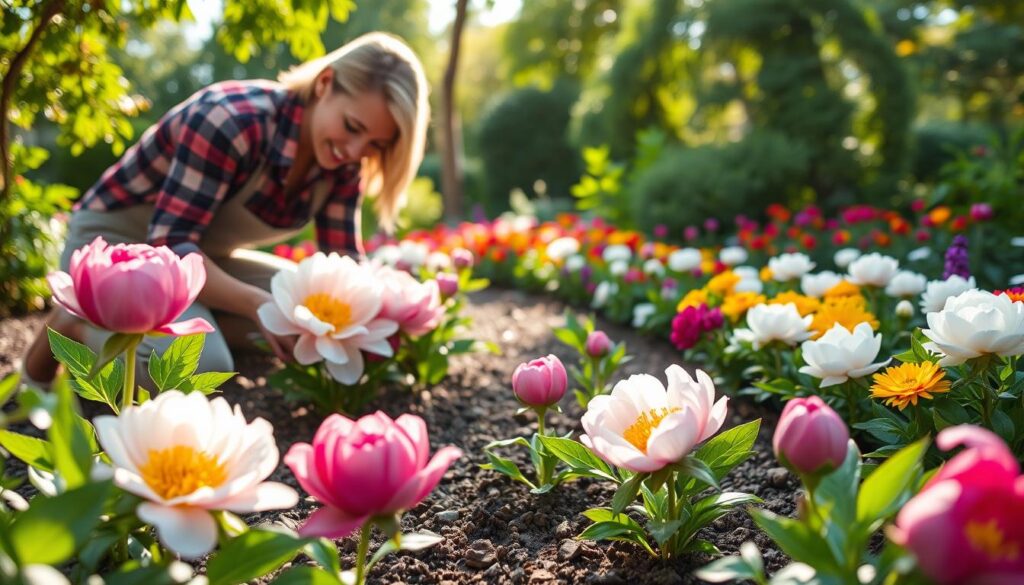
By following these steps and thinking about your garden’s future, your peonies will thrive. Remember, taking care of your garden is key for your peonies Flowers to last long and look great.
Watering and Fertilization Guidelines
Proper care of peonies Flowers includes knowing how to water and fertilize them. Peonies need careful watering to avoid root rot. They need about 1 inch of water each week, from rain or irrigation.
Creating a seasonal watering plan is key. This plan should match the weather and your peonies’ needs at different times. Here are some tips for a seasonal watering plan:
Seasonal Watering Schedule
- Spring: Water peonies often in spring, but don’t overdo it to prevent root rot.
- Summer: Cut back on watering in summer since peonies are more prone to root rot in heat and humidity.
- Fall: Keep watering peonies Flowers regularly in fall, but less often as it gets cooler.
Fertilizing is also vital for peonies’ health and blooms. Use a balanced, slow-release fertilizer. When picking a fertilizer, consider these points:
Fertilizer Types and Application
Choose a fertilizer made for perennials like peonies. Follow the instructions to avoid overfertilizing. Also, know common watering errors like too much or too little water, which can harm your peonies.
Common Watering Mistakes
By following these tips and avoiding common mistakes, you can give your peonies Flowers the right water and nutrients. Always focus on proper care and water management for a healthy peony garden.
| Season | Watering Frequency | Fertilization |
|---|---|---|
| Spring | Regularly | Apply balanced fertilizer |
| Summer | Reduced | Avoid fertilization during hot weather |
| Fall | Regularly | Apply balanced fertilizer |
Supporting and Staking Your Blooms
Proper care for peonies means giving them the support they need for their big, heavy flowers. This is where flower support tips come in handy. Stakes or cages help keep these flowers standing tall, showing off their beauty and protecting the plant. It’s important to support them without harming the plant or limiting its growth.
For staking perennials, use single stakes for smaller plants and cages for bigger ones. With peonies Flowers, gentle handling is key to avoid harming the stems or flowers. Soft ties or clips work well to tie the stems to the stakes, ensuring the plant can still grow.
Here are some tips for supporting your peony blooms:
- Use sturdy stakes that can withstand wind and weather conditions
- Place the stakes near the plant, but not so close that they damage the roots
- Secure the stems to the stakes using soft ties or clips
- Monitor the plant’s growth and adjust the support as needed
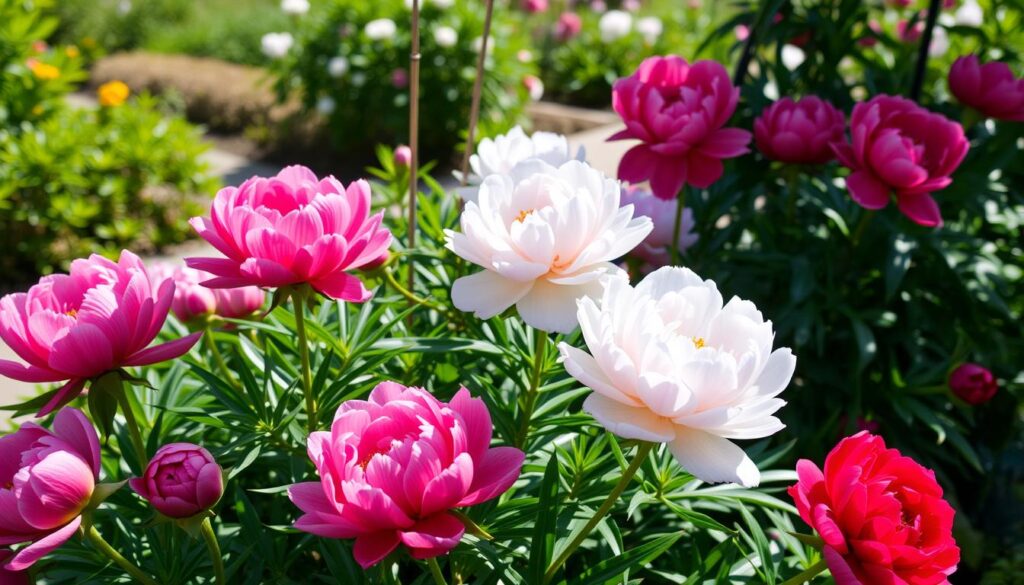
By following these tips and providing the right support, you can enjoy your peonies’ blooms longer. Remember to handle your plants with care. They will reward you with beautiful, thriving flowers.
Creating Color Combinations with Companion Plants
Companion planting is a smart way to make your garden look good. Pairing peonies Flowers with other plants brings out beautiful colors and textures. This attracts visitors and pollinators, making your garden a hit.
When designing your garden, think about when each plant blooms and what color it is. For example, peonies look great with spring bulbs like tulips or daffodils. Summer plants like daylilies or coneflowers add to the peonies’ beauty. And in fall, asters or sedum keep your garden interesting.
Spring Combinations
- Tulips and peonies: a classic combination that creates a stunning display of colors and textures
- Daffodils and peonies: a great way to add some early spring color to your garden
- Crocuses and peonies: a beautiful combination that creates a vibrant and dynamic display
Summer Pairings
In summer, daylilies or coneflowers are perfect with peonies. They add color in mid-summer and make your garden look amazing.
Fall Garden Integration
In fall, asters or sedum keep your garden lively. They add late-season color and create a beautiful display of colors and textures.
Disease Prevention and Management
Peonies need care to stay healthy and beautiful. Good gardening tips help prevent diseases like powdery mildew or botrytis. Make sure to provide enough air and remove any infected parts.
Here are some key strategies for managing diseases in peonies:
- Remove infected parts to stop disease spread
- Don’t water from above to keep leaves dry
- Ensure good airflow to stop fungus growth
By following these tips, you can keep your peonies Flowers healthy and vibrant. Regular checks and care are crucial for disease prevention and management.
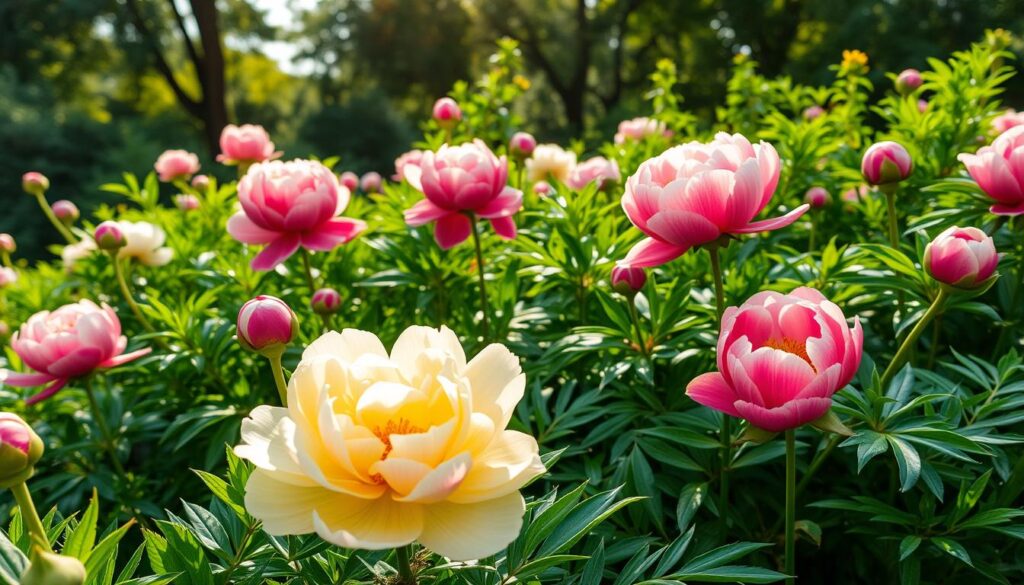
It’s also vital to know how to handle disease outbreaks. This might include using fungicides or other treatments. A proactive approach to disease prevention ensures your peonies will bloom for many years.
Pruning and Maintenance Throughout the Year
Proper care of peonies Flowers means regular pruning and upkeep. This keeps them healthy and beautiful. Follow key gardening tips and pruning methods to ensure your peonies thrive all year.
In spring, it’s important to remove dead leaves and divide or transplant peonies. This gives them a strong start and encourages growth. In summer, keep the area around your peonies weed-free and ensure they get enough water. This is crucial for their growth and blooming.
Seasonal Tasks
- Spring: Remove dead foliage, divide or transplant peonies Flowers as needed
- Summer: Keep the area weed-free, ensure adequate moisture
- Fall: Cut back foliage, and add a layer of mulch for winter protection
- Winter: Protect the plants from extreme cold and moisture
By doing these seasonal tasks, your peonies will look great all year. Always prune correctly to avoid harming your plants. With the right care and tips, you can enjoy these lovely flowers for many years.
By adding these pruning and maintenance steps to your gardening routine, you’ll enjoy your peonies’ beauty all year.
| Season | Task | Importance |
|---|---|---|
| Spring | Remove dead foliage | High |
| Summer | Keep area weed-free | Medium |
| Fall | Cut back foliage | High |
| Winter | Protect from extreme cold | Medium |
Propagation Methods for Expanding Your Garden
If you want to grow more peonies or share them with friends, propagation methods are a great way to do it. You can divide mature peonies Flowers in the fall after they’ve stopped blooming. This method helps you spread these lovely flowers across your garden.
Here are some important gardening tips for peony propagation:
- Divide the roots carefully to avoid damaging them
- Replant the divided roots immediately, making sure they are at the same depth as before
- Water thoroughly after replanting to settle the soil
Good peonies Flowers care is key for successful propagation. Make sure to water, fertilize, and give them enough sunlight. By following these gardening tips and using the right propagation methods, your peony garden will flourish for years.
| Step | Description |
|---|---|
| 1 | Divide the roots of mature plants in the fall |
| 2 | Replant the divided roots immediately |
| 3 | Water thoroughly after replanting |
Designing Your Peony Garden Layout
When planning a peony garden, think about the plants’ size, bloom times, and how they fit in your garden. A well-thought-out design can greatly enhance your outdoor space’s beauty and function.
Peonies need the right sunlight, water, and food to thrive. Knowing these needs helps you create a vibrant peony garden. Mixing peonies with other plants in a bed can lead to a beautiful flower arrangement.
Border Designs
A border with peonies as the centerpiece can be breathtaking. Use a mix of short and tall plants for a layered effect.
Focal Point Planning
Make peonies the main attraction in your garden. Place a large peony in the center or group them for a stunning display.
Mixed Garden Beds
Mixing peonies with other plants adds depth and variety. Choose plants with different textures, colors, and bloom times for a dynamic garden.
Follow these tips to create a beautiful and functional garden. Consider peonies’ unique traits to showcase these stunning flowers.
Cutting and Arranging Peonies for Indoor Display
Peonies are a favorite for flower arrangements because of their big, beautiful blooms and soft leaves. To make a gorgeous flower arrangement, you need to know how to cut and prepare peonies right. This means taking off lower leaves and putting them in a vase with fresh water to keep them alive longer.
Here are some gardening tips for taking care of peonies:
- Cut peonies in the early morning or late evening when the sun is not intense.
- Use sharp, clean scissors or pruning shears to prevent damaging the stems.
- Remove any leaves that will be below the waterline to prevent bacterial growth.
By using these gardening tips, you can make a beautiful flower arrangement with your peonies. Adding other flowers or leaves can make your arrangement even more interesting. It will be a beautiful addition to any room.
Here’s a table with more tips to help your flower arrangement last longer:
| Tip | Description |
|---|---|
| Watering | Change the water in the vase every 2-3 days to keep the peonies fresh. |
| Temperature | Keep the peonies away from direct sunlight and heat sources to prolong their vase life. |
| Humidity | Maintain a humid environment to prevent the peonies Flowers from drying out. |
Troubleshooting Common Peony Problems
Peonies are usually tough plants, but they can face issues. Taking good care of them is key to avoiding and fixing these problems. Issues like not blooming, becoming too tall, or getting pests or diseases can happen.
To solve these problems, you need to find out what’s causing them. For instance, if your peonies don’t bloom, it might be because they don’t get enough light or water. Changing your gardening ways can help fix these issues and make your peonies flourish.
Here are some common problems and how to solve them:
- Failing to bloom: Check the planting depth, soil quality, and sunlight exposure.
- Becoming too leggy: Provide support using stakes or a trellis.
- Pests or diseases: Use organic or chemical treatments as needed.
By following these tips and being ready to tackle common peony problems, you can have healthy and stunning peonies in your garden. Always focus on proper care and problem-solving to keep your peony plants thriving.
Conclusion: Creating Your Perfect Peony Paradise
Creating a perfect peony garden is a labor of love. It involves mastering peony care, designing your garden, and arranging these blooms. You can turn your outdoor space into a peony paradise, whether you’re experienced or new to gardening.
Understanding peonies’ needs is key to a thriving garden. This includes soil prep and companion planting. With the right knowledge, you can overcome challenges and create a garden that delights everyone.
Starting your peony-growing journey is exciting. Peonies are not just beautiful; they have a rich history. Let your garden show your passion, creativity, and love for nature’s beauty.
FAQ
What are the different types of peonies Flowers?
Peonies come in many shapes, sizes, and colors. You can find herbaceous, tree, and intersectional peonies. Each type has its own special charm and features.
What is the historical significance of peonies?
Peonies Flowers have a long history, being grown in China for over 1,500 years. They are famous for their stunning blooms.
What are the ideal soil requirements for growing peonies?
Peonies love well-drained soil that’s slightly acidic to neutral. The pH should be between 6.0 and 7.0. Adding compost or well-rotted manure can make the soil better for your peonies.
How should peonies be planted for success?
Planting peonies right is key. Choose healthy plants and plant them at the correct depth. Space them well to fit your garden design.
What are the best watering and fertilization practices for peonies?
Water and fertilize your peonies well. They need about 1 inch of water a week. Use a balanced, slow-release fertilizer at the right time for best growth and blooms.
How can I support and stake peony blooms?
Some peonies have big, heavy blooms that need support. Stakes or cages can keep them upright, showing off their beauty and protecting the plant.
What companion plants work well with peonies?
Pair peonies with spring bulbs, summer perennials, and fall asters or sedum. This creates stunning garden scenes and extends the blooming season.
How can I prevent and manage diseases in my peony garden?
Keep your peonies healthy by providing good air circulation and removing infected parts. Avoid overhead watering. If disease happens, know how to manage it with fungicides or other treatments.
How do I prune and maintain peonies throughout the year?
Prune and maintain your peonies by removing dead foliage, dividing or transplanting, and keeping weeds away. Add mulch in the fall for their health and look all year.
How can I propagate peonies to expand my garden?
You can propagate peonies by dividing mature plants in the fall. This method is best after they’ve stopped blooming. Knowing how to do it can help you grow more of these lovely flowers.

